Burundi has a tradition of forming associations and our development projects are encouraged to organize project associations. True development involves cooperation between and among community members and association members. Whereas all of our development projects involve intra-association cooperation, there are some opportunities for inter-association cooperation.
Cooperation within Associations:
Within Kabezi Commune and the same community, we have two very successful development projects and three active associations of women who are all actively and cooperatively involved in animal husbandry and agriculture. The first project, Improved Food Security at Kabezi (2012), has been very successful in distributing goats to its members and planting, harvesting, sharing and selling crops (see description below).
The first project and first association has distributed goats to all of its 20 members, developed an extension project and a second association of women who agreed to distribute goats and plant, harvest and distribute crops. The first association provided a number of goats to the members of the second association (see description below).
The second development project, Development of Vegetable Culture for the Self-Financing of IAP Twubake (2013), has also been successful in developing an association of poor women, distributing animals (first rabbits and now goats) and cultivating, sharing and selling crops (see description below).
Cooperation among Associations:
With three associations in the same community, there is an opportunity to build on the established within association cooperation (intra-association cooperation) and develop some new among associations cooperation (inter-association cooperation).
All three associations have been active in growing crops but the association members have used their own hoes. The President of the first association has repeatedly asked for money and stressed the need and importance of acquiring new hoes for the association members. In response to her requests, I would explain that Haley McCready Outreach and Development Fund provides start-up grants but has no program to provide additional money.
Informally, a few Canadians have provided some gifts with the request that the money be used to support the development projects. In January of this year, I was visiting our two projects and three associations in Kabezi. In response to yet another request for hoes, I indicated that I would be willing to provide a gift from a Canadian donor to buy a limited number of hoes, providing the three associations would be willing to discuss and support an inter-association cooperation program to share the hoes with all association members. The associations agreed to the challenge.
In August, I returned to Kabezi and asked about the cooperative hoe program. The three associations had considered the offer and agreed to accepting the gift for hoes and the cooperative conditions. So, I asked each of the three association Presidents if they agreed to purchase, store, distribute and maintain the hoes cooperatively. All the Presidents agreed and I presented them with the gift ($100.00 US).

After I left, the three associations sent 6 representatives to the RIZIBA market to buy 33 new hoes for the use of all 62 association members.
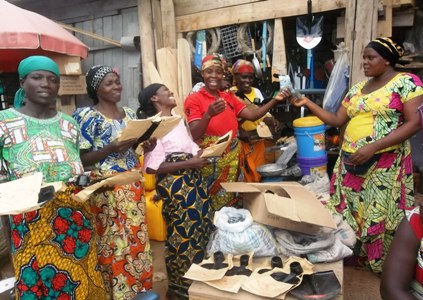
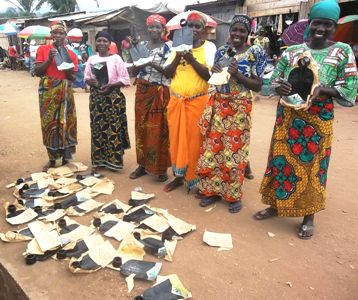
At a collective meeting of the three associations, all of the members agreed to an unexpected indigenously-created expansion to the proposed cooperative hoe program. The members agreed to have all of the association members; each of the 62 members, contribute a special fee of 2,600 francs that would allow for the purchase of 29 more new hoes. Accordingly, the association members extended the cooperation program and cooperatively contributed their own money so that each of the 62 association members can have a new hoe to use for collective agricultural work and the agricultural work of the families. If you support indigenous self-governance like we do, you have to admire the creative collective inter-association decision to use self-support to expand the inter-association cooperation.
Improved Food Security at Kabezi (2012), Project Mangers, Marie Nadège TWAGIRAYEZU and Anicet NYANDWI
Project Description:
This very successful project was designed to recruit and organize poor women who would work together to improve their lives through animal husbandry and agriculture. The project recruited women who were willing to join an association, receive and distribute goats and become involved in the collective planting, harvesting and selling of crops.

Initial Project, First Association:
At the beginning, five poor women were given a female goat and agreed to pass on a female kid to another woman who agreed to join the association, pass on a kid and work on collective crops. The project has built the first association of 20 active members, distributed 20 goats. Each of the original 20 women now has a number of goats.
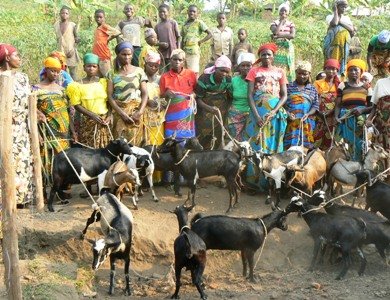
The project has been active in collectively growing crops. The women have been trained in composting, organic fertilizing, growing beans, soya beans, tomatoes, maize (corn), sweet potatoes and cassava and crop diversification and erosion prevention. Some of the harvest is distributed to members, some saved for seed and some sold for income. The association has used its financial holdings to buy its own collective field. Some of the association’s collective money is also used to provide small loans to association members for small income-generating activities (micro-financing).

Extension Project, Second Association:
As planned, the first association has developed a second association of 22 female members who agreed to participate in the same development activities (develop an association, distribute goats and grow crops). The first association distributed a few goats to the new association members and the process of distributing goats is continuing. Likewise, the second association members have received training in planting and growing crops.
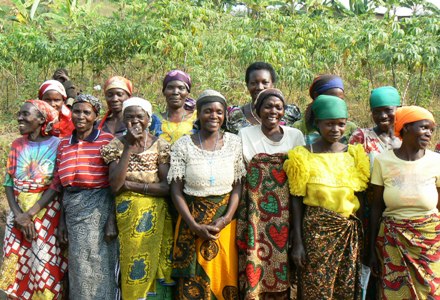


Development of Vegetable Culture for the Self-Financing of IAP Twubake (2013), Project Manager, Anicet NYANDWI
Project Description:
This project was designed to use a participatory, self-help, cooperative approach to organize and train 20 poor women in the cultivation and sale of vegetables, the raising of rabbits and create an association and, thereby, develop a bigger and better diet, ongoing work and income.

Project Results:
The project has an association of the 17 poor widows and 3 poor orphan women. Some time ago, the project manager bought and distributed three rabbits to each of the 20 women; a total of 60 rabbits.

The women have planted and harvested crops of tomatoes, cabbage, maize (corn), cassava and beans. The harvests are shared with the association members, some of the harvest is saved for seed and the remainder is sold with some of the proceeds going to the association and some to the members. The cultivation process is used to train the women on composting, inter-cropping, across the hill line planting, fertilizing, mulching, irrigating, erosion prevention and crop rotation.

Expanding Animal Husbandry:
The association decided to expand its animal husbandry; the association decided to buy 4 goats and draw names to distribute the first 4 goats to 4 members who will in turn distribute the kids to other members based on the initial draw of names. The association hopes that soon all of the women will have at least one goat.
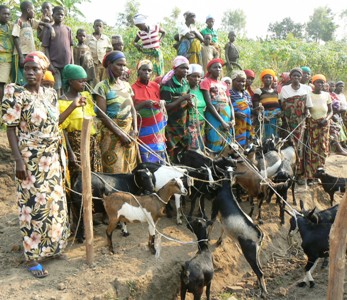
Continuing Agriculture and Micro-financing:
The women work together on fields where they share in the harvest and they also work in teams for other people, get paid and, then, split the money among all members of the association. The association has used some of its money to for micro-financing purposes, providing some of its members with small loans for small income-generating activities such as re-selling vegetables, salt and oil.

